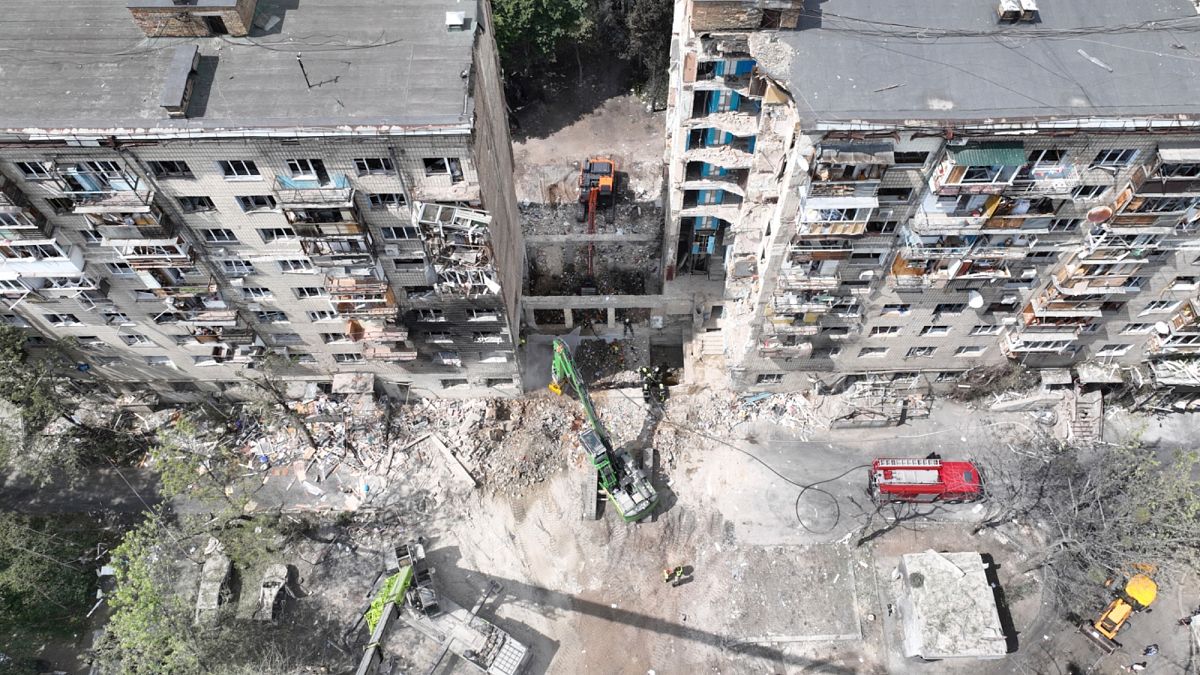Larysa Hnatchenko has been at the helm of Slobidskyi Kray, the Kharkiv region’s oldest newspaper, for more than 14 years.
However, following the Trump administration’s decision to slash 90% of USAID grants in January, she has been doing something she did not expect she would have to do, just to keep working.
Hnatchenko has been dipping into her personal savings to ensure the publication’s survival — using her money to pay salaries, office rent and fuel expenses.
“On top of this all, we were already owed two months’ money when they paused the funding,” she told Euronews.
While most of Slobidskyi Kray’s team left Kharkiv in February 2022 following Russia’s full-scale invasion, they returned after the city’s liberation, committed to continuing reporting.
The team began organising the distribution of 3,000 newspapers each week — for free — to humanitarian hubs located in 20 communities across the Kharkiv region.
“The goal of distributing the newspapers was not to generate a profit, but to ensure that people living in occupied territories and front-line regions got the news,” Hnatchenko said.
“It’s impossible to offer a subscription service in these areas, because people don’t know where they will be from one day to the next due to the constant shelling.”
“Many grandmothers would walk to humanitarian hubs by foot as they were determined to get the newspaper,” added Hnatchenko.
This has now come to a halt due to a lack of funds. US grants previously made up 50% of the Slobidskyi Kray’s funding — while nine out of 10 local Ukrainian outlets were also heavily reliant on USAID.
Hnatchenko fears that cuts to USAID are playing into the hands of the Kremlin, leaving many vulnerable individuals who are exposed to Russian disinformation, with no alternative news sources.
“It’s a real issue, we can no longer afford to deliver our newspapers to areas which have no electricity or access to Ukrainian news. Many occupied and frontline territories also do not have Ukrainian signal but instead Russian signal, which is a trap,” said Hnatchenko.
Opening the space to Russian disinformation
While Ukraine’s media market has proven resilient, a report conducted by the media monitoring organisation Reporters Sans Frontières (RSF) prior to the axing of USAID funding found that Ukrainian media outlets needed $96 million (€86.3 million) over a three-year period to cover their costs.
“There are no current figures on how many Ukrainian media outlets have had to close down since the end of USAID, but we know that more 330 outlets have had to shut down since Russia launched its full-scale invasion of Ukraine,” Pauline Maufrais, Ukraine area manager for RSF, told Euronews.
“Russian propaganda outlets rejoiced in the end of USAID because it weakens the coverage from Ukrainian outlets especially in areas which are close to the front,” said Maufrais.
In January, RSF published an investigation into the International Reporters outlet, which publishes Moscow’s propaganda and sends its contributors — such as French citizen and naturalised Russian national Christelle Néant — to interview the local population in occupied eastern Ukraine, including Avdiivka and Mariupol.
The International Reporters outlet is just one of the many Kremlin-funded propaganda networks, which use foreign propagandists to justify Russia’s invasion of Ukraine internationally.
“If there are fewer journalists in the Ukrainian media because there are not enough financial resources to pay them back, this means that less topics will be covered,” said Maufrais.
“Since USAID cuts, media outlets are able to hire fewer freelancers, staffers have lost their jobs, but it also means that there is less coverage on the ground coming out from Ukraine.”
“Some outlets are running with only a few weeks of financing left, while others have said they can online survive until June,” Maufrais added.
Documentaries on halt
Vgoru Media, based in Kherson — a city on the front lines of the war which was occupied by Russia for a period of nine months — previously relied on USAID to fund 80% of its projects.
“We have had to cut big projects, such as our documentary telling the story of women who were kidnapped and tortured by Russia, as all the funding was from USAID,” Ustyn Danchuk, head of video journalism at Gwara Media told Euronews.
“We had already made 60% of the film when the cuts were implemented — but we hadn’t even been paid for that work,” he explained.
Many Vgoru journalists left Kherson when it was under Russian occupation, fearing being captured and tortured. Since they have returned, they must live with the daily threat of missiles, as well as constant fear.
For Danchuk, reporting and ensuring that locals don’t fall for Russian disinformation is key.
“I produce a video format where I walk around the streets of Kherson and ask people questions. What I have found is that young and middle-aged people want justice for Ukraine if the war is to end, they do not want swathes of the country to be handed over in exchange for peace,” he explained.
But this might not be enough, and the Kremlin’s influence is still felt among the residents, Danchuk said. His outlet was also forced to cut a fact-checking video project countering Russian historical myths — one of the key tools in Moscow’s propaganda arsenal.
“I see that a lot of older people fall for the Russian narrative, many believe that ‘we have to make peace with Russians, that every conflict ends and that we must be friends again.'”
“We are continuing to try and tackle disinformation through our articles, but we are able to do a lot less without USAID,” concluded Danchuk.

